Costume Picture Gallery: In the Kitchen and Market
The following is a collection of images of working women that should provide
good ideas for typical clothing for the women in the kitchen and markets
around the Poulet Gauche. Click on the images to see larger versions
of them. For the most part, the upper middle classes and the nobility are
not represented here.
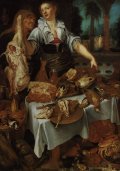 Detail
from A Kitchen Scene by Pieter Cornelisz van Ryck, 1604. It
is a naughty picture in 16th century terms -- all the meat is clearly a
metaphor for the pleasures of the flesh, the old woman looks like a matchmaker
(or worse, a procuress), and the young cook in the center is clearly in
some disarray, with her partlet undone. There is a biblical scene in the
background, contrasting the fates of the rich man and the beggar, so the
picture is of course a very moral one. We think of this woman as being
the "Poulet Gauche Poster Girl."
Detail
from A Kitchen Scene by Pieter Cornelisz van Ryck, 1604. It
is a naughty picture in 16th century terms -- all the meat is clearly a
metaphor for the pleasures of the flesh, the old woman looks like a matchmaker
(or worse, a procuress), and the young cook in the center is clearly in
some disarray, with her partlet undone. There is a biblical scene in the
background, contrasting the fates of the rich man and the beggar, so the
picture is of course a very moral one. We think of this woman as being
the "Poulet Gauche Poster Girl."
The best source of information on how to make this sort of woman's outfit
can be found at Drea Leed's site on the Fleming
Working Woman's Dress.
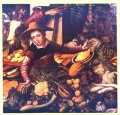 Market
Woman With Vegetable Stall, by Pieter Aertsen, 1567. This woman
is wearing a black over-partlet (which ties under the arms) and a white
linen partlet with ruff underneath it. Both are work on top of the
bodice and underdress. This style of bodice seems to be very typical
of region. The lacing is very wide apart, the bodice edges falling almost
from the shoulder edge, and the underdress shows very clearly through it.
This bodice has little cap sleeves, to which a separate pair of long sleeves
are pinned. This is clearly a fall scene, and the woman needs to keep warm!
Market
Woman With Vegetable Stall, by Pieter Aertsen, 1567. This woman
is wearing a black over-partlet (which ties under the arms) and a white
linen partlet with ruff underneath it. Both are work on top of the
bodice and underdress. This style of bodice seems to be very typical
of region. The lacing is very wide apart, the bodice edges falling almost
from the shoulder edge, and the underdress shows very clearly through it.
This bodice has little cap sleeves, to which a separate pair of long sleeves
are pinned. This is clearly a fall scene, and the woman needs to keep warm!
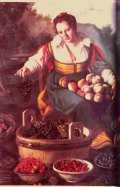 The
Fruit Seller, by Vincenzo Campi, 1580. This is an Italian women, wearing
a characteristically Italian style dress. It fastens up the front using
hooks and eyes which are not visible. As it typical of the school, this
is a rather romanticized young peasant, with her gay ribbons and bits of
trim.
The
Fruit Seller, by Vincenzo Campi, 1580. This is an Italian women, wearing
a characteristically Italian style dress. It fastens up the front using
hooks and eyes which are not visible. As it typical of the school, this
is a rather romanticized young peasant, with her gay ribbons and bits of
trim.
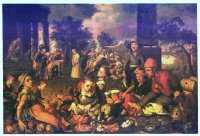 Christ
and the Adulteress, by Pieter Aertsen, 1559. The biblical scene is
being enacted in the background -- the vendors in the market place in the
foreground dominate the picture. Many, if not most, market vendors were
women. While their husbands worked the fields or plied their trade,
they would go to the market to sell the goods. This scene has men in it
also, and from a costuming point of view they are especially interesting.
The one in the left foreground is wearing a "thrummed cap" -- a type of
cap with fleece bits pulled through and sticking out, rather like a hooked
rug. He is wearing wooden sabots with ridges on the bottom to keep the
wearing above the mud and muck. He is also wearing what look to our modern
eye like trousers -- they are loose, straight-cut, and come to the ankle.
He is also wearing a shirt whose simplicity of cut resembes a modern long-sleeved
T-shirt. There is an elderly man behind him to the left. He is also wear
the same type of trousers and and interesting jacket. This one has long
sleeves, and is cropped at the waist, but sometimes the sleeves were short
and the jacket came to mid-thigh. It wraps around and fastens at the side.
Men are often shown with this garment unfastened and hanging open.
Christ
and the Adulteress, by Pieter Aertsen, 1559. The biblical scene is
being enacted in the background -- the vendors in the market place in the
foreground dominate the picture. Many, if not most, market vendors were
women. While their husbands worked the fields or plied their trade,
they would go to the market to sell the goods. This scene has men in it
also, and from a costuming point of view they are especially interesting.
The one in the left foreground is wearing a "thrummed cap" -- a type of
cap with fleece bits pulled through and sticking out, rather like a hooked
rug. He is wearing wooden sabots with ridges on the bottom to keep the
wearing above the mud and muck. He is also wearing what look to our modern
eye like trousers -- they are loose, straight-cut, and come to the ankle.
He is also wearing a shirt whose simplicity of cut resembes a modern long-sleeved
T-shirt. There is an elderly man behind him to the left. He is also wear
the same type of trousers and and interesting jacket. This one has long
sleeves, and is cropped at the waist, but sometimes the sleeves were short
and the jacket came to mid-thigh. It wraps around and fastens at the side.
Men are often shown with this garment unfastened and hanging open.
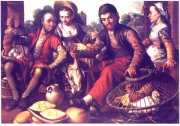 Poultry
Vendors, by Joachim de Beuckelaer, 1563. Another market scene of poultry
sellers. The woman on the right is wearing a rather sheer collarless partlet
over her bodice. The men are wearing their overjackets open and loose,
and we have examples of both long loose "pants" and regular hose being
worn with them. The fellow on the right is wearing a thrummed cap.
Poultry
Vendors, by Joachim de Beuckelaer, 1563. Another market scene of poultry
sellers. The woman on the right is wearing a rather sheer collarless partlet
over her bodice. The men are wearing their overjackets open and loose,
and we have examples of both long loose "pants" and regular hose being
worn with them. The fellow on the right is wearing a thrummed cap.
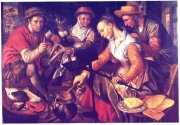 Making
Waffles, by Joachim de Beuckalaer, 1550-1560. Another suggestive cooking
scene. We see here the same costume elements as before. The older woman
in the background is wearing a wimple-like scarf. Although women generally
covered their heads in some way, older women and widows were more likely
to cover themselves even more.
Making
Waffles, by Joachim de Beuckalaer, 1550-1560. Another suggestive cooking
scene. We see here the same costume elements as before. The older woman
in the background is wearing a wimple-like scarf. Although women generally
covered their heads in some way, older women and widows were more likely
to cover themselves even more.
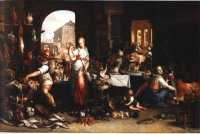 Kitchen
Scene, by Joachim Antonisz Uytaewael, 1605. Another erotic kitchen
scene, with the cook spitting a chicken in the center of the picture (apparently
a suggestive activity to the 16th century mind). She is wearing the same
type of clothing as the woman in the van Ryck kitchen scene, only her partlet
is more decently done up. There are two men in the picture. they are wearing
trunk hose, gathered to just above the knee. In both cases their nether
hose (stockings) are falling down. I think this was probably pretty typical
for working men. The stockings come just above the knee normally
and are gartered, usually just below the knee, but since elastic hadn't
yet been invented, it would not be untypical for the socks to still end
up coming down around your ankles all the time. This scene has wonderful
details of redware, cooking utensils, and orange carrots. Most carrots
at the time were white.
Kitchen
Scene, by Joachim Antonisz Uytaewael, 1605. Another erotic kitchen
scene, with the cook spitting a chicken in the center of the picture (apparently
a suggestive activity to the 16th century mind). She is wearing the same
type of clothing as the woman in the van Ryck kitchen scene, only her partlet
is more decently done up. There are two men in the picture. they are wearing
trunk hose, gathered to just above the knee. In both cases their nether
hose (stockings) are falling down. I think this was probably pretty typical
for working men. The stockings come just above the knee normally
and are gartered, usually just below the knee, but since elastic hadn't
yet been invented, it would not be untypical for the socks to still end
up coming down around your ankles all the time. This scene has wonderful
details of redware, cooking utensils, and orange carrots. Most carrots
at the time were white.
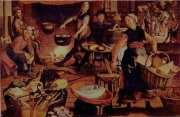 Detal
from Dutch Kitchen, by Pieter Aertsen, 1560. Notice how short the skirt
is of the women in the center of the frame -- working women could not afford
to wear skirts that would get in the way and trip them up.
Detal
from Dutch Kitchen, by Pieter Aertsen, 1560. Notice how short the skirt
is of the women in the center of the frame -- working women could not afford
to wear skirts that would get in the way and trip them up.
 Supper
at Emmaus, Flemish, 16th c.. This is a great kitchen scene. The biblical
event is taking place in the background to the left, but the kitchen is
much more interesting.
Supper
at Emmaus, Flemish, 16th c.. This is a great kitchen scene. The biblical
event is taking place in the background to the left, but the kitchen is
much more interesting.
 The
Egg Dance, Pieter Aertsen, 1557. This scene is particularly interesting
for the male costume. It's one of the few kitchen scenes where male characters
dominate over female ones.
The
Egg Dance, Pieter Aertsen, 1557. This scene is particularly interesting
for the male costume. It's one of the few kitchen scenes where male characters
dominate over female ones.
 Home
to Poulet Gauche
Home
to Poulet Gauche Bibliography
Bibliography
-c.
t. iannuzzo
 Detail
from A Kitchen Scene by Pieter Cornelisz van Ryck, 1604. It
is a naughty picture in 16th century terms -- all the meat is clearly a
metaphor for the pleasures of the flesh, the old woman looks like a matchmaker
(or worse, a procuress), and the young cook in the center is clearly in
some disarray, with her partlet undone. There is a biblical scene in the
background, contrasting the fates of the rich man and the beggar, so the
picture is of course a very moral one. We think of this woman as being
the "Poulet Gauche Poster Girl."
Detail
from A Kitchen Scene by Pieter Cornelisz van Ryck, 1604. It
is a naughty picture in 16th century terms -- all the meat is clearly a
metaphor for the pleasures of the flesh, the old woman looks like a matchmaker
(or worse, a procuress), and the young cook in the center is clearly in
some disarray, with her partlet undone. There is a biblical scene in the
background, contrasting the fates of the rich man and the beggar, so the
picture is of course a very moral one. We think of this woman as being
the "Poulet Gauche Poster Girl."








